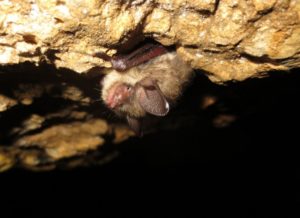 To protect ourselves from infectious disease, we often strive to avoid close contact with those who are sick. But new, surprising findings from bat research reveal that pathogens can move from individual to individual much easier and more frequently than we thought.
To protect ourselves from infectious disease, we often strive to avoid close contact with those who are sick. But new, surprising findings from bat research reveal that pathogens can move from individual to individual much easier and more frequently than we thought.
A team of biologists from several institutions throughout the United States, including Northern Arizona University researchers Jeffrey Foster and Katy Parise, looked at how disease spreads in bats, particularly the deadly white-nose syndrome that has been decimating bat populations in North America since 2006.
“When we think about who we might get sick from, we tend to think of our social groups: family, friends and co-workers. But, we forget about the contact that happens when picking up something at the Post Office, having a brief interaction with a barista at a coffee shop, or sharing airspace on public transportation,” said Virginia Tech Research Scientist Joe Hoyt, who led the study. “People are aware of these interactions, but not how important they are to the spread of epidemics. In the past, these types of hidden interactions have been poorly understood and historically dismissed because they are so difficult to quantify.”
He calls these casual, potentially infectious contacts, “cryptic connections,” pathways between individuals that would not normally be considered significant in the spread of disease.
But the explosive epidemic of the white-nose syndrome in bats has shocked and mystified biologists who have observed how entire populations could be infected within a month or two. Because bats eat massive amounts of insects that kill trees and plants, this fungal disease that is wiping out huge populations of bats is destroying millions of acres of forests and crops.
The team set out to understand how white-nose syndrome was spreading so quickly, especially among hibernating colonies.
Using seven different colors of fluorescent powder to simulate spores of the fungus, researchers dusted individual bats of various species – some more social than others – in a Michigan cave. They gently coated the bats and worked the dust into their fur, wings and tails. With an ultraviolet light, they could see the powder glow where the bats touched down or brushed by, and what other bats picked it up. They were able to create a network of how the dust was spread.
“It’s hard to figure out how disease transmission is happening. If someone touches his nose and then a doorknob, it’s difficult to track all the people who touched it. You can’t visualize a pathogen in the environment,” said Foster. “With the powder, we can track how the fungus is likely spreading. We can see all the places bats have contacted.”
Their findings were astonishing. Just one bat could be responsible for transferring dust to 75 percent of the population. “There is huge potential for rapid spread,” said Hoyt. “That’s what we’re seeing with this disease once it gets into these populations. In thousands of bat sites where there are 25,000 bats, nearly 100 percent are infected over a couple of months. For any disease, that’s kind of unheard of.”
They also learned that bats move around a lot during hibernation, a time when their metabolism slows and their immune system is ratcheted down.
“If you go into a cave in the winter, you’ll see the bats stationary on the top of the cave, hanging there. You don’t think that they move. They barely wake up,” said Foster. “But we could see from the fluorescent dust on their faces or the tips of their wings that they are having lots of contact.”
White-nose syndrome showed up in the area after the fluorescent dust studies were conducted.
Foster and Parise, who work in NAU’s Pathogen and Microbiome Institute, found that the actual fungus spread similarly to how the powder was dispersed.
Foster explains that, unlike bacteria, a fungus can live in the environment for a long time. The fungus that causes white-nose syndrome can exist on the walls of caves for years. “It’s important to know where the fungus is likely going and tracking it, which has been tough in the past.”
Hoyt says the bat research has broader implications when considering disease outbreaks in humans and livestock. “We want to know how might a pathogen get into that population so we can be prepared, and better understand how disease is transmitted for future control strategies.”
Any pathogen that shows up in the environment, even for a short period of time, has the potential to expand a lot, says Hoyt. “If you consider the Ebola virus 2014 outbreak, we pretty much don’t know what the connection was when the disease left the wildlife reserve to the first human case. Once the disease gets into human routes of transmission, cryptic connections could be really important to understand.”
Ebola is a deadly disease that first showed up in monkeys and gorillas and transferred to people in Africa. Hoyt cites other viruses of concern that spillover from wildlife to humans such as the Hendra virus, a disease in horses that spread to individuals in Australia and the Nipah virus, which showed up in pig farmers in Malaysia and Singapore.
Unfortunately, Foster says the bats will find a way to survive the white-nose syndrome before scientists do by building up an immunity; however, he says, the National Science Foundation-funded eight-year study provides important insight into the global spread of disease. FBN
By Bonnie Stevens, FBN
Photo caption: Researchers dusted individual bats with ultraviolet fluorescent powder that resembled fungal spores to track all the places and individuals with whom they had contact.
Photo courtesy of Joe Hoyt







